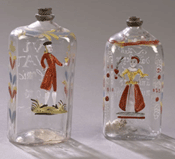|
Tips for Identifying Early American Glass
By Anne Gilbert
When even the "experts" can be fooled by what is supposed to be authentic
late-18th to mid-19th century American glass, does a beginning collector have a
chance? While it may be discouraging, there is a lot of help if you are willing
to do the research. Recently in an auction catalog, I spotted what were supposed
to be late 18th century bottles with enameled figures and Pennsylvania Dutch
type motifs.
Research would tell you otherwise. You would learn that the two
most-wanted types of American glass, South Jersey and Stiegel are the most
confusing to collectors.
It was the 18th century glass house of Caspar
Wistar, in southern New Jersey where the free blown glass we know as South
Jersey or Wistarberg was made. It is among the earliest known American glass
houses. When South Jersey glass is mentioned, what usually comes to mind is an
aqua-colored object with lily pad decorations. The dominate colors of the pieces
were light green and aquamarine.
Wistar, who was from Germany, actually had
no knowledge of the glassmaking processes and hired experts from Holland and
Germany.
CLUES: To an untrained eye, the enameled pieces made at Henry
William Stiegel's glass house in Manheim, Penn., would seem easy to recognize.
However, the same type of enameled work was also made in Switzerland, Germany
and Bohemia. His workmen who came from those countries imitated the glass they
were familiar with. The pieces were done with copper wheel engraving. The
enameled pieces used white, wavy scallop or red and mustard colored line
borders. Folk figures, animals and steeples were often combined with
inscriptions.
Many museum reproductions are sold not only in museum gift
shops but in the secondary market as antiques. South Jersey and enameled pieces
often turn up as antiques at small auctions and out-of-the-way shops. Look on
the bottom for evidence of removal of the museum name or newly manufactured
dates that show up as scratches.
Faking of the early South Jersey pieces
became a full time occupation in the late 1930s for the Clevenger Brothers and
Emil J. Larson. The Clevengers specialized in the lily pad pieces while Larson
made Stiegel-type glass. The Clevenger pieces are heavy in comparison with
authentic items. When recognized, the prices are much lower. Both men were
master glassblowers.
Boston & Sandwich lacy glass cup plates were heavily
reproduced in the 1960s and on. Authentic pieces have a bell-like ring when
tapped. Repros emit a dull thud.
To learn more, try and find copies of The
Phaidon Guide to Glass by Felice Mehlman, usually in museum gift shops, and the
classic book, American Glass by George and Helen McKearin.
|

A pair of Stiegel-type spirits bottles. (Photo, Cowan auctions, Cincinnati,
OH.) |